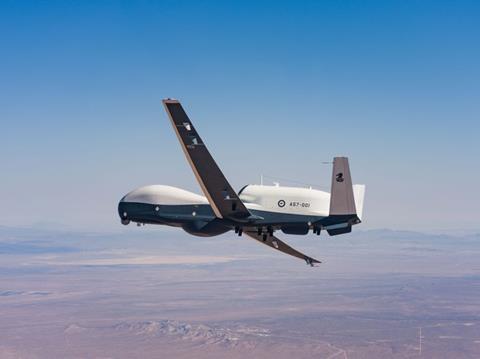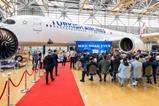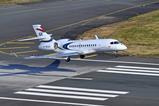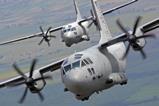Northrop Grumman continues to chase international sales opportunities for its E-2D Advanced Hawkeye and MQ-4C Triton maritime surveillance aircraft, as it simultaneously introduces upgrades to both platforms.
While the US Navy (USN) remains the anchor customer for the two platforms, Northrop is confident of building on the modest number of export orders already booked, says Jane Bishop, vice-president and general manager of the global surveillance division at Northrop Grumman Aeronautics Systems.

France and Japan are the sole non-domestic customers for the E-2D airborne early warning and control aircraft, having respectively committed to three and 13 examples; both are existing operators of the earlier C-model variant.
While Tokyo already has six units in service, Cirium fleets data records, the aircraft destined for Paris are still in development as Northrop works on “France-specific capabilities”, Bishop said at the Royal International Air Tattoo at RAF Fairford in the UK on 19 July. Deliveries are due in 2028.
Northrop is continuing to market the E-2D to other existing C-model customers Egypt and Taiwan, “who have interest in taking the next step”, and is also in discussions with Poland, says Bishop.
Meanwhile, the manufacturer is working on a five-year, $1 billion upgrade programme for the USN. A series of steps will see the platform gain a mixture of hardware and software updates, eventually delivering a new cockpit, rear operator station displays and mission computer.
“It’s about bringing the technology up to the latest and greatest,” says Bishop, as well as dealing with obsolescence issues.
With the US Air Force last year beginning the divestment of its ageing fleet of Boeing E-3 Sentry airborne warning and control system aircraft, Bishop argues the E-2D could be a “great gap filler” while the service waits for the first of its 26 new Boeing E-7 Wedgetails to arrive from 2027.
Cirium data shows that on top of the French and Japanese aircraft, the USN has an additional 14 Advanced Hawkeyes still to be delivered.

In parallel, Northrop is also hoping to progress potential export sales of the Triton uncrewed air vehicle (UAV). So far, the single customer outside the USN is Australia, which has committed to four units of the high-altitude, long-endurance (HALE) maritime surveillance platform.
Canberra’s first example was handed over on 14 June, with the delivery to be celebrated later this month.
Bishop points to the UAV’s “active production line”, adding: “For any international ally concerned about maritime domain awareness, we see Triton as a great solution.”
Earlier this year, Norway published its latest defence spending plan, through which it intends to acquire a fleet of “long-range” UAVs for maritime surveillance missions, particularly in the high north.
Bishop says the company is in discussions with Oslo regarding its requirements and has provided “classified briefing materials” around the Triton’s capabilities. Norway is likely to publish an analysis of alternatives by early 2025.
NATO is also eyeing a five-aircraft Triton order, with funding already in place for “long-lead material”, while Japan also presents “an opportunity”.
Bishop says the jet-powered MQ-4C is also a “great complement” for the Boeing P-8 Poseidon as it “really frees up the P-8 to perform the anti-submarine warfare mission”. Northrop is actively pitching the Triton at existing Poseidon customers, she adds.
The manufacturer also has a “capability roadmap” to enhance the UAV, says Bishop. “We are continuing to evolve the Triton to keep the platform relevant,” she adds. “We are upgrading the sensors to see smaller targets at longer ranges.”






















































